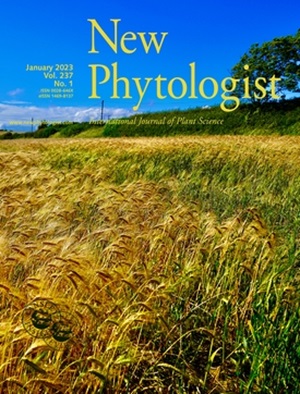Leaf warming in the canopy of mature tropical trees reduced photosynthesis due to downregulation of photosynthetic capacity and reduced stomatal conductance
IF 8.3
1区 生物学
Q1 PLANT SCIENCES
引用次数: 0
Abstract
- Tropical forests play a large role in the global carbon cycle by annually absorbing 30% of our annual carbon emissions. However, these forests have evolved under relatively stable temperature conditions and may be sensitive to current climate warming. Few experiments have investigated the effects of warming on large, mature trees to better understand how higher temperatures affect these forests in situ.
- We targeted four tree species (Endiandra microneura, Castanospermum australe, Cleistanthus myrianthus and Myristica globosa) of the Australian tropical rainforest and warmed leaves in the canopy by 4°C for 8 months. We measured temperature response curves of photosynthesis and respiration, and determined the critical temperatures for chloroplast function based on Chl fluorescence.
- Both stomatal conductance and photosynthesis were strongly reduced by 48 and 35%, respectively, with warming. While reduced stomatal conductance was likely in response to higher vapour pressure deficit, the biochemistry of photosynthesis responded to higher temperatures via reduced Vcmax25 (−28%) and Jmax25 (−29%). There was no shift of the Topt of photosynthesis. Concurrently, respiration rates at a common temperature did not change in response to warming, suggesting limited respiratory thermal acclimation.
- This combination of physiological responses to leaf warming in mature tropical trees may suggest a reduced carbon sink with future warming in tropical forests.
求助全文
约1分钟内获得全文
求助全文
来源期刊

New Phytologist
生物-植物科学
自引率
5.30%
发文量
728
期刊介绍:
New Phytologist is an international electronic journal published 24 times a year. It is owned by the New Phytologist Foundation, a non-profit-making charitable organization dedicated to promoting plant science. The journal publishes excellent, novel, rigorous, and timely research and scholarship in plant science and its applications. The articles cover topics in five sections: Physiology & Development, Environment, Interaction, Evolution, and Transformative Plant Biotechnology. These sections encompass intracellular processes, global environmental change, and encourage cross-disciplinary approaches. The journal recognizes the use of techniques from molecular and cell biology, functional genomics, modeling, and system-based approaches in plant science. Abstracting and Indexing Information for New Phytologist includes Academic Search, AgBiotech News & Information, Agroforestry Abstracts, Biochemistry & Biophysics Citation Index, Botanical Pesticides, CAB Abstracts®, Environment Index, Global Health, and Plant Breeding Abstracts, and others.
 求助内容:
求助内容: 应助结果提醒方式:
应助结果提醒方式:


